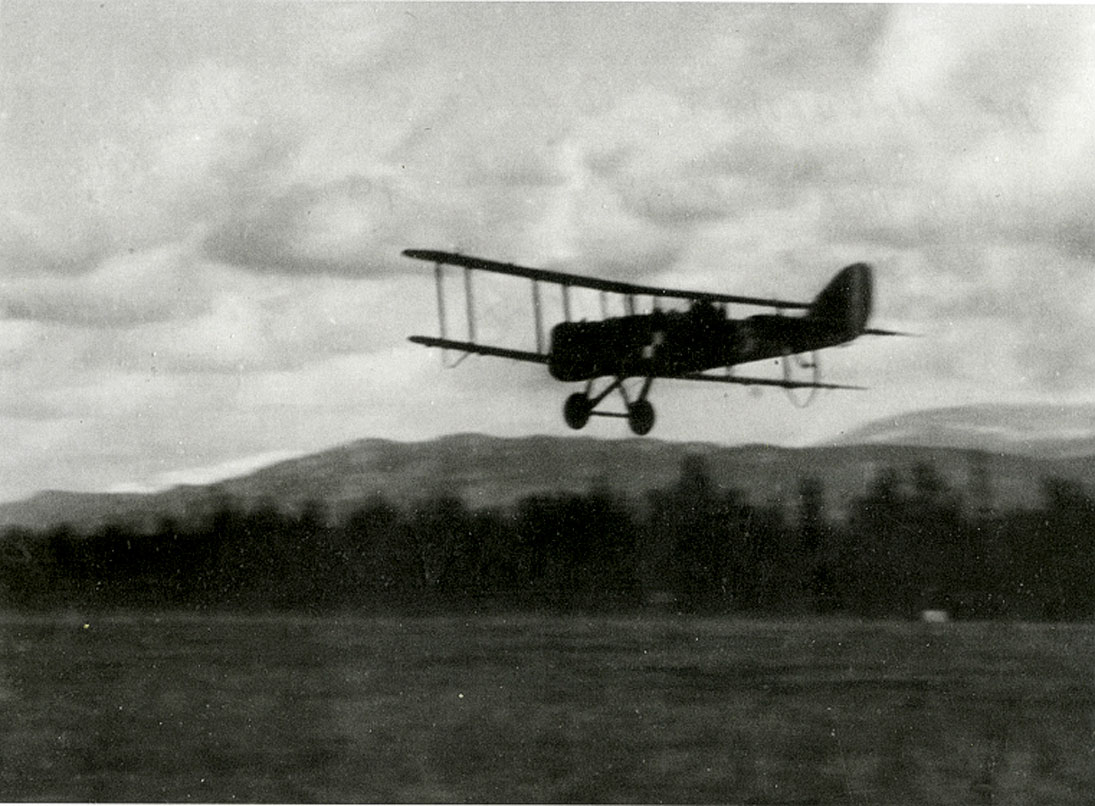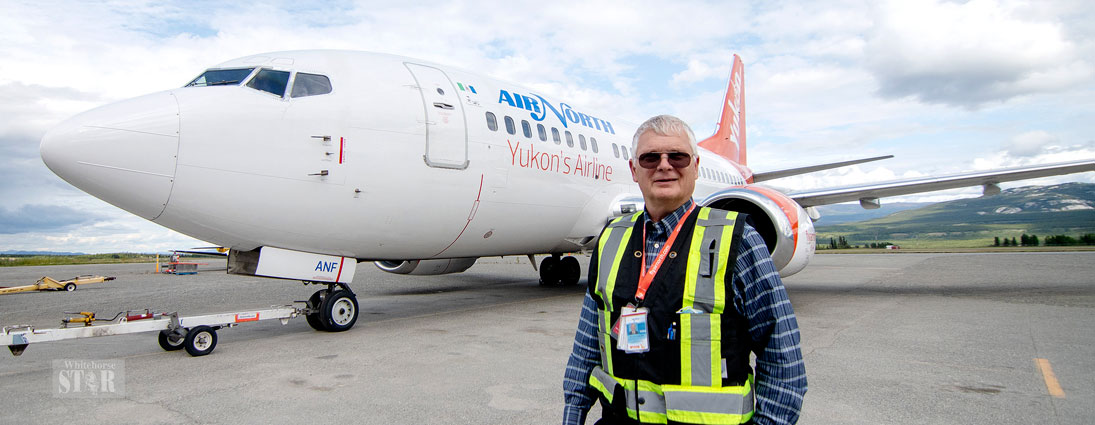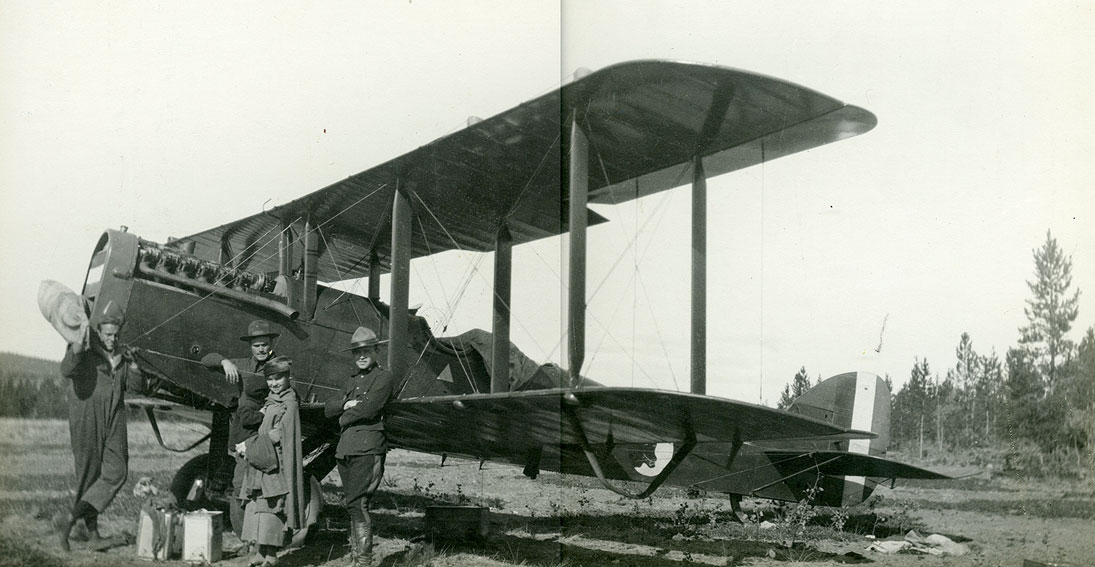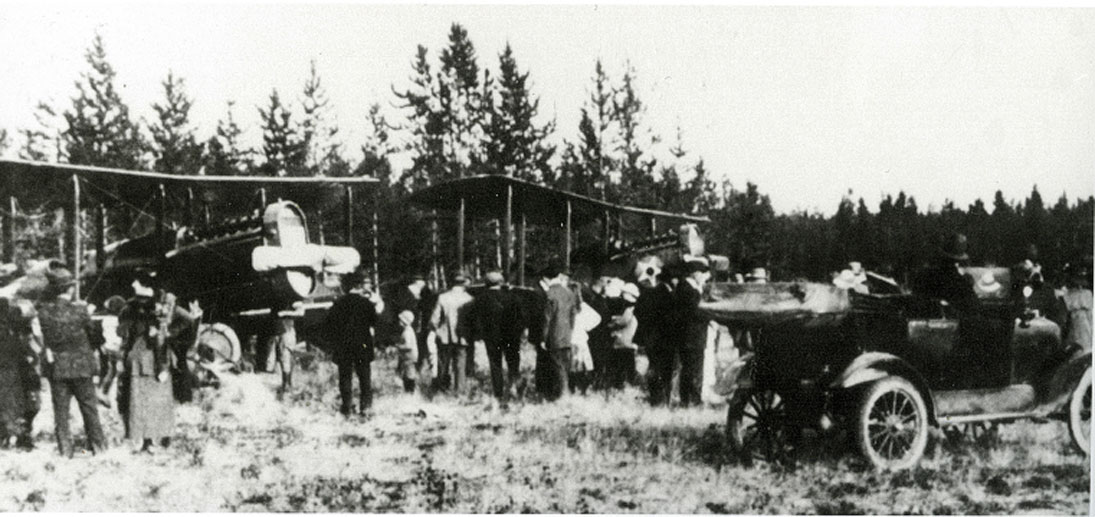Yukoners poised to celebrate aviation milestone
With a little imagination, one can turn back the clock 100 years and imagine what it must have been like to see the first aircraft, never
having seen anything like it in the skies overhead.
By Chuck Tobin on August 14, 2020
With a little imagination, one can turn back the clock 100 years and imagine what it must have been like to see the first aircraft, never
having seen anything like it in the skies overhead.
It was hundred years ago this Sunday that the first aircraft touched down in Whitehorse.
The four de Havilland DH-4 bi-planes, known as the Black Wolf Squadron, were part of an international effort to demonstrate the
viability of long distance flight.
They flew from New York to Nome, Alaska, and back.
To mark the historic occasion, the Yukon Transportation Museum will host a celebration Sunday to commemorate 100 Years of Yukon
Aviation.
The museum has posted a story on its website about the history of aviation, with recollections from aviation historians like Whitehorse
resident Bob Cameron.
It includes a time line of the first 100 years, from the arrival of de Havillands through to the success today of the Air Norths, the Alkan
Airs....
In the introduction to his book Yukon Wings, Cameron writes: “This is the true story of the human drama, the grit and the determination,
the gutsiness and the passion, the triumph and the tragedy, that ultimately forged reliable scheduled and charter air service to, from and within the Yukon.”
In advance of the arrival of the first planes, an advance team of two arrived in Whitehorse on June 18 to ensure a site had been chosen
for the airstrip, and aviation fuel would be available. The Erik Nielsen Whitehorse International Airport is located today on the site of the original airstrip.
The four de Havillands started the 14,400-kilometre round trip on July 15, 1920 and arrived here on Aug.16 after making several
refuelling stops as they travelled west across the U.S. and Canada.
The flew to Dawson City the next day, Discovery Day.
“The deep hum, almost before we could realize it, was standing directly above our heads,” reads the description of the event by a
Dawson City newspaper reporter.
“And then, the great dragonfly as if in joyous exaltation of having caused so much excitement among the earthbound mortals, gracefully
circled about as if to show its wonderful capabilities and mastery of the air.”
Janna Swales, the museum’s executive director, says in an interview this week those first aircraft for many must have been UFOs –
Unidentified Flying Objects.
Imagine, says Swales, looking skyward 100 years ago and seeing these machines flying through the air, machines you’d never seen
before.
“That is what it was to people when they came over the horizon, those de Havillands,” she says.
Swales said local artists Nicole Bauberger and Heather Von Steinhagen have collaborated on an exhibit titled Encounters for the
anniversary celebration.
It includes several paintings around the theme of the wonders one might see, surprise encounters, she says.
She says the museum has put in place measures to ensure physical distancing is maintained. It will be open Sunday from 11 a.m. to 5
p.m.
Swales says local artist and commercial pilot Ukjese van Kampen has provided five paintings of historic aircraft for display, including a
painting of the storied CP-CPY which now sits on a pedestal as a weather vane in front of the museum.
Van Kampen in 1994 started Tutchone Air, which was the first fully-owned First Nation airplane company in the Yukon.
The past May, his daughter, Shadunjen van Kampen, became the first, First Nation woman in the territory to obtain her commercial licence.
Sunday will also feature local pilots flying circuits around the airport between noon and 2 p.m.
At city council’s meeting on Monday, Mayor Dan Curtis proclaimed Aug. 16, 2020 as 100 Years of Yukon Aviation Day.
Rick Nielsen remembers when he obtained his private pilot’s licence, resulting from a bet with his father, the late Erik Nielsen, who served as the Yukon’s Member of Parliament for 29 years, beginning in 1957.
The airport is named after the former MP who flew the Lancaster bomber in the Second World War and also flew commercially in the
Yukon part-time after moving here in 1952 to take a job as a lawyer.
It was at his father’s home on Quiet Lake when the two were sitting on the deck in 1978 looking down at his dad’s float plane. His father
bet him he could not get his private pilot’s licence in 30 days.
As a mechanic for the Whitehorse Copper Mine, which was on strike at the time, Rick took up the challenge.
“I had time,” Rick recalls this week. “I went everyday to the Whitehorse flying School. It was literally the 30th day, the last day of the month, I was able to earn my pilot’s licence.”
Though he never had aspirations of flying commercially, it wasn’t long after receiving his private licence that he obtained his commercial licence.
And not long after that, he began flying a float plane commercially for Air North Charter and Training, a new company started in 1977 by Joe Sparling and Tom Wood.
Rick went on to become a partner in Alkan Air with Hugh Kitchen.
To this day, Rick maintains his commercial licence. He doesn’t fly commercially much anymore but he is the chief operations officer for
Air North, the company that grew from a single Cessna 172 in 1977 into “Yukon’s Airline” today with is fleet of Boeing 737s and turbo-
prop aircraft.
Air North, says Rick, is an amazing story of a company with an air-tight commitment to the Yukon.
Ryan Kinney, born and raised in Whitehorse, started out with Air North as a baggage handler working the ramp.
Today, Kinney is a 737 captain and the director of flight operations for the company, Rick points out.
It’s the same story for others such as Mark Bowen, who worked as a helper around the shop as a young man who today serves as Air
North’s director of maintenance.
Rick quips that while he goes by Rick, his given name is Erik, after his father, and it’s the name Erik on his official identification.
It’s prompted a question or two from airport officials over the years: Erik Nielsen landing at the Erik Nielsen airport?
Rick’s nephew and his father’s grandson, Erik Temple, flies today with the Snowbirds, Canada’s military aerobatics demonstration team.
Cameron remembers as a young boy growing up in Whitehorse how he wanted to be a pilot just like his dad, Gordon Cameron, who was an aircraft engineer or mechanic and had his private pilot’s licence.
“I grew up in the aviation culture, the aviation business, because my dad was in it,” he says. “All the years I was growing up, most of the
men I knew were his colleagues, pilots and engineers, so I guess I aspired as a young child to be just like them.”
In 1962, at the age of 17, Cameron earned his private licence and went on to obtain his commercial licence in 1970.
He flew in the industry for more than 30 years, and to this day remains immersed in the aviation culture as a historian passionately
involved with the restoration of old aircraft that flew in the Yukon. They’re on display at the transportation museum, and van Kampen
has captured a couple of them in his artwork.
The early decades of flight in the Yukon were hard, says Cameron.
He says pilots and flight engineers had to be tough to endure.
In the remote Yukon wilderness, in frigid winter temperatures, they’d have to tarp over their engines and light fires underneath to warm
them up so they could start them.
And they’d have to stay underneath, breathing toxic fumes, to make sure the plane did not catch on fire.
He says there is just something about getting the job done in an aircraft made of wood, welded steel and covered in fabric.
He remembers the last of that era, before the de Havilland Beaver came along.
“The aircraft of the day seemed to have more character,” says Cameron. “They all had their own personalities.
“And I think the pilots and engineers that flew them back in those days had to be a little tougher.”




Comments (8)
Up 0 Down 0
Dennis on Aug 20, 2020 at 11:27 am
We transferred to Yukon in 1986. Over the years I got to meet and know many of those mentioned. I served in other northern communities. The Pilots, including my bro-in-law (now 86) were always community Leaders and Examples. Certainly no difference in Whitehorse. A fine article and thanks to these Yukon Leaders.
Up 2 Down 1
Wayne Ellis on Aug 17, 2020 at 9:31 pm
how cool
Up 5 Down 1
Bob on Aug 17, 2020 at 8:27 pm
The book "Yukon Wings" is quite an accomplishment. Unfortunately, the facts are all pretty well "Whitehorse" based and I strongly feel the book should have been titled "Whitehorse Wings".
Up 7 Down 1
comen sense on Aug 17, 2020 at 10:56 am
Went to the transportation museum Sunday, nothing.
Up 4 Down 2
Lee Nielsen on Aug 17, 2020 at 5:11 am
No cake, no admission break, no thanks.
Up 15 Down 0
Christian KLEIN on Aug 15, 2020 at 8:16 am
Could we make a special anniversary trip to the historical Carcross airstrip when the weather is better? The first commercial airway business in Yukon started in Carcross before Whitehorse. The old hangar is still there.
Up 7 Down 4
Biggles-wick on Aug 15, 2020 at 6:11 am
My word but that was a long article . The writer couldn’t be stopped - Chuck’s away !
Up 5 Down 7
JC on Aug 14, 2020 at 5:16 pm
Could they not have shown a picture.